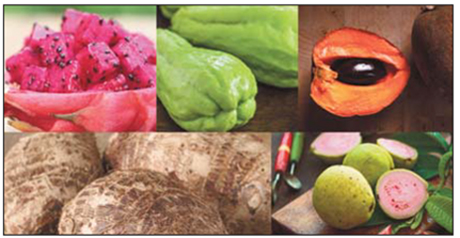Welcome to Blue Book!
Are you ready to join the thousands of companies who rely on Blue Book to drive smarter decisions? View our plans and get started today!
Still have questions? We’d love to show you what Blue Book can do for you. Drop us a line– we’ve been waiting for you.

CHAYOTE: VEGETABLE OR FRUIT?
A member of the gourd family, chayote (Sechium edule) is native to central Mexico and thought to be one of the oldest cultivated plants within the Western Hemisphere. While it’s commonly thought of and treated as a squash, chayote is often called a ‘vegetable pear’ and is actually a tropical fruit.
From Mexico, chayote’s popularity spread to Central America where it is a staple of daily diets. Chayote can also be found growing in exotic locales like India, China, and Hawaii. Most of the chayote consumed in the United States comes from Mexico and Costa Rica, although one variety, known as a mirliton, grows in the summer in southern Louisiana.
Most chayote are pear-shaped and sport light-green wrinkled skin, although one variety is covered in needle-like spines. Inside, the flesh is pale and firmer than a zucchini, and at the center is a large seed. Younger fruits can be eaten unpeeled and with the seed, while the riper chayote should be both peeled and seeded.
A versatile commodity, chayote can be eaten raw, boiled, sautéed, baked, or stuffed. The flavor is mild, even bland, making it an ideal ingredient for sauces and stews. It also has a long shelf life: once ripe, a chayote can sit for a few weeks before spoiling.
WAITING IN THE WINGS
More than a few other exotic fruits and vegetables are awaiting their turn in the spotlight. Among those still considered specialty items—perhaps because of cost, limited or seasonal availability, or little or no marketing—but enjoying wider appeal are feijoa, cherimoya, and guanábana.
Feijoa, also known as the pineapple guava, is a South American plant native to southern Brazil and northern Argentina as well as parts of Uruguay, Paraguay, and Chile. It’s also grown in California, where the season runs from October to January, and is most commonly eaten raw for dessert or in salads. It’s not on everyone’s radar yet, but its popularity is increasing.
Cherimoya, on the other hand, is enjoying a boom. Noted by Mark Twain as one of the most delicious fruits known to mankind, it is also called the custard apple or sugar apple and is native to the Andes and available year-round, thanks to a growing season in Chile from June to January and in California from February to May. This fruit’s rise to the top may be thwarted by its price tag.
“Cherimoya is one of our most distributed exotic fruits in the United States,” confirms Schueller of Melissa’s/World Variety Produce. While he’s seen the origins of a trend in demand, he concedes “the expense prohibits many retailers from carrying it.” Those with a hankering for this specialty commodity can find it, mostly in Hispanic, Asian, or high-end retailers.




